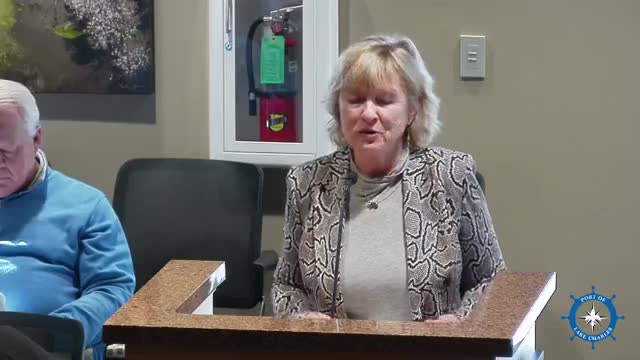Louisiana's Fast Start Program showcases success in carbon reduction technologies
April 22, 2024 | Associated Branch Pilots for the Port of Lake Charles, Boards & Commissions, Organizations, Executive, Louisiana

This article was created by AI summarizing key points discussed. AI makes mistakes, so for full details and context, please refer to the video of the full meeting. Please report any errors so we can fix them. Report an error »

The recent meeting of the Lake Charles Harbor and Terminal District on April 22, 2024, highlighted significant developments in the region's energy sector, particularly focusing on the Fast Start program and the ongoing projects aimed at reducing carbon emissions.
The meeting began with an enthusiastic presentation about the Fast Start program, which has been recognized as one of the best in the nation for supporting companies in Louisiana. The program, which has been operational for 16 years, was praised for its extensive resources and support for businesses, showcasing the state's commitment to fostering economic growth.
A key topic of discussion was the carbon intensity of local energy projects. The National Energy Technology Laboratory reported that the carbon intensity for similar plants is 5.75, while the local facility has achieved a significantly lower rate of 2.68. This reduction is attributed to strategic decisions made by the project team, including the use of waste heat and syngas, which minimizes reliance on natural gas and lowers emissions. These environmentally sensitive practices position the project favorably in the eyes of potential partners and investors.
The meeting also addressed the successful signing of long-term natural gas agreements with BP, securing the necessary resources for the next two decades. This agreement is crucial for advancing construction permits, primarily from Citgo, which are expected to be finalized shortly.
Permitting updates were another focal point, with the team reporting progress on obtaining necessary environmental permits. A hearing was scheduled to discuss the Title 5 permit, which is essential for compliance with pollution standards. The permitting agency expressed satisfaction with the project's environmental evaluations, indicating a positive outlook for the upcoming hearing.
On the financial front, the team is actively pursuing both debt and equity financing, with a target to close by September. However, potential delays in the Department of Energy's environmental impact statement could pose challenges. The team is preparing to engage with banks as a backup plan, ensuring that financing remains on track.
The meeting concluded with updates on technical aspects of the project, including equipment bidding and construction timelines. The anticipation of receiving substantial funds at closing, estimated at over $2.4 million, underscores the project's financial viability and its importance to the local economy.
Overall, the discussions at the Lake Charles Harbor and Terminal District meeting reflect a proactive approach to energy transition and environmental responsibility, positioning the region as a leader in sustainable energy practices. The next steps will involve navigating the permitting process and securing financing to ensure the project's successful implementation.
The meeting began with an enthusiastic presentation about the Fast Start program, which has been recognized as one of the best in the nation for supporting companies in Louisiana. The program, which has been operational for 16 years, was praised for its extensive resources and support for businesses, showcasing the state's commitment to fostering economic growth.
A key topic of discussion was the carbon intensity of local energy projects. The National Energy Technology Laboratory reported that the carbon intensity for similar plants is 5.75, while the local facility has achieved a significantly lower rate of 2.68. This reduction is attributed to strategic decisions made by the project team, including the use of waste heat and syngas, which minimizes reliance on natural gas and lowers emissions. These environmentally sensitive practices position the project favorably in the eyes of potential partners and investors.
The meeting also addressed the successful signing of long-term natural gas agreements with BP, securing the necessary resources for the next two decades. This agreement is crucial for advancing construction permits, primarily from Citgo, which are expected to be finalized shortly.
Permitting updates were another focal point, with the team reporting progress on obtaining necessary environmental permits. A hearing was scheduled to discuss the Title 5 permit, which is essential for compliance with pollution standards. The permitting agency expressed satisfaction with the project's environmental evaluations, indicating a positive outlook for the upcoming hearing.
On the financial front, the team is actively pursuing both debt and equity financing, with a target to close by September. However, potential delays in the Department of Energy's environmental impact statement could pose challenges. The team is preparing to engage with banks as a backup plan, ensuring that financing remains on track.
The meeting concluded with updates on technical aspects of the project, including equipment bidding and construction timelines. The anticipation of receiving substantial funds at closing, estimated at over $2.4 million, underscores the project's financial viability and its importance to the local economy.
Overall, the discussions at the Lake Charles Harbor and Terminal District meeting reflect a proactive approach to energy transition and environmental responsibility, positioning the region as a leader in sustainable energy practices. The next steps will involve navigating the permitting process and securing financing to ensure the project's successful implementation.
View full meeting
This article is based on a recent meeting—watch the full video and explore the complete transcript for deeper insights into the discussion.
View full meeting
